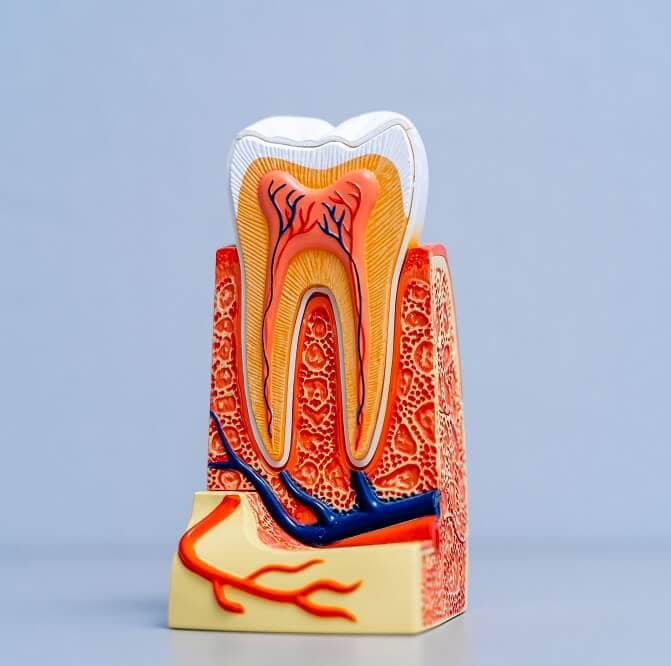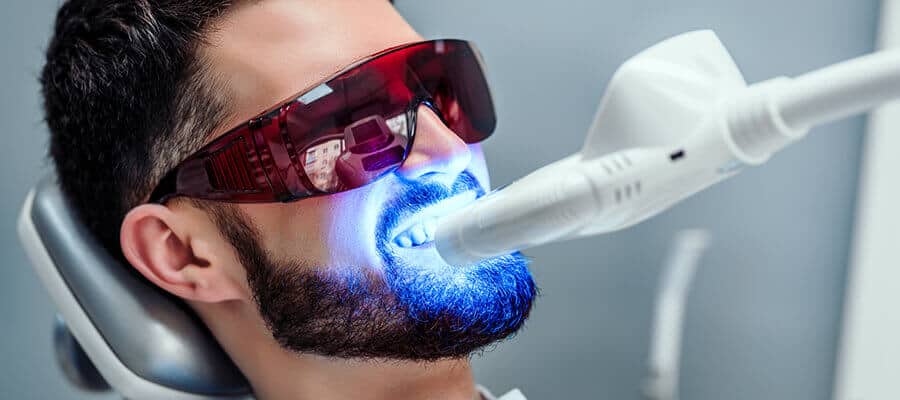
Root canal therapy is needed when the nerve of a tooth is affected by decay or infection. In order to save the tooth, the pulp (the living tissue inside the tooth), nerves, bacteria, and any decay are removed and the resulting space is filled with special, medicated, dental materials, which restore the tooth to its full function.
Having a root canal done on a tooth is the treatment of choice to save a tooth that otherwise would die and have to be removed. Many patients believe that removing a tooth that has problems is the solution, but what is not realized is that extracting (pulling) a tooth will ultimately be more costly and cause significant problems for adjacent teeth.
Root canal treatment is highly successful and usually lasts a lifetime, although on occasion, a tooth will have to be retreated due to new infections.
Signs and symptoms for possible root canal therapy:
- An abscess (or pimple) on the gums.
- Sensitivity to hot and cold.
- Severe toothache pain.
- Sometimes no symptoms are present.
- Swelling and/or tenderness.
Reasons for root canal therapy:
- Decay has reached the tooth pulp (the living tissue inside the tooth).
- Infection or abscess have developed inside the tooth or at the root tip.
- Injury or trauma to the tooth.
What does root canal therapy involve?
A root canal procedure requires one or more appointments and can be performed by a dentist or endodontist (a root canal specialist).
While the tooth is numb, a rubber dam (a sheet of rubber) will be placed around the tooth to keep it dry and free of saliva. An access opening is made on top of the tooth and a series of root canal files are placed into the opening, one at a time, removing the pulp, nerve tissue, and bacteria. If tooth decay is present, it will also be removed with special dental instruments.
Once the tooth is thoroughly cleaned, it will be sealed with either a permanent filling or, if additional appointments are needed, a temporary filling will be placed.
At the next appointment, usually a week later, the roots and the inside cavity of the tooth will be filled and sealed with special dental materials. A filling will be placed to cover the opening on top of the tooth. In addition, all teeth that have root canal treatment should have a crown (cap) placed. This will protect the tooth and prevent it from breaking, and restore it to its full function.
After treatment, your tooth may still be sensitive, but this will subside as the inflammation diminishes and the tooth has healed.
You will be given care instructions after each appointment. Good oral hygiene practices and regular dental visits will aid in the life of your root canal treatment.
FAQs
What does a root canal entail?

Root canals are a common restorative dental procedure that is designed to eliminate infection from the inner canals of a tooth and protect it from potential microbial invasion. It entails removing damaged or infected pulp, a thorough cleansing of the tooth’s interior, and subsequent filling and sealing of the tooth to restore its functionality.
Why would I require this procedure?
A root canal may be necessary if the tooth pulp becomes infected or damaged due to deep decay, multiple dental procedures on the tooth, or physical trauma leading to cracks or chips.
What symptoms suggest the need for a root canal?
Indications for a root canal may include intense pain, a tooth that is temperature-sensitive, swelling and tenderness in the gums, or even darkening of the tooth. These symptoms may suggest inflammation or infection of the tooth pulp, necessitating the need for a root canal treatment.
How is the root canal procedure performed?
The process typically involves the removal of the infected or inflamed pulp, cleaning and disinfecting the inner root canals of the tooth, and then sealing those spaces with a material called gutta-percha. The tooth is usually capped with a crown to reinforce its structure and improve aesthetics.
Is the procedure or recovery painful?
Root canal treatments are commonly performed to alleviate pain caused by a damaged tooth. With modern dental anesthesia, the procedure is usually painless. Any discomfort after the procedure can typically be managed with over-the-counter pain relievers.
What is the success rate of root canal treatments?
Root canals are safe and effective procedures. When performed correctly, a tooth that has been treated with root canal therapy can have the same longevity of a naturally healthy tooth.
What is the aftercare following a root canal?

After getting a root canal, you will need to adhere to Dr. Rader‘s aftercare instructions. These may include instructions to avoid chewing on the treated tooth until it has been fully restored. This helps prevent recontamination and ensures the integrity of the restoration. Additionally, maintaining good oral hygiene and attending regular dental check-ups will contribute to the long-term health of the treated tooth.
Are there teeth that cannot be treated with a root canal?
Most teeth can undergo a root canal, but in some cases where the damage is extensive, or the anatomy of the tooth’s roots is complex, alternative treatments may be recommended.
What does recovery look like?
After a root canal procedure, it is typically safe to return to your regular daily activities within 24 hours. However, it is advisable to avoid engaging in heavy or strenuous activities for a few days to minimize the risk of discomfort or potential issues arising from the treatment.
What is the risk of reinfection?
While root canals generally have a high success rate, there is still a possibility of reinfection in a treated tooth. This can occur due to a faulty seal or new decay that exposes the root canal filling material to bacteria. Regular check-ups play a crucial role in detecting and addressing such issues early, helping to prevent reinfection.
Is root canal treatment expensive?
Root canal costs vary depending on the extent of damage as well as the tooth that is to be treated. Generally, it is less expensive than tooth extraction and replacement.






